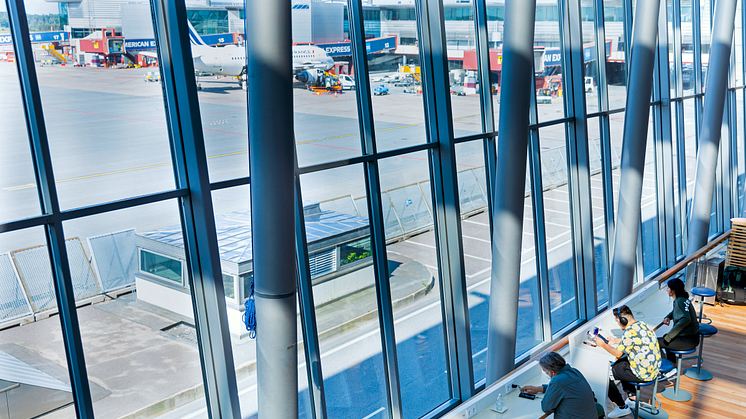Nearly 2.9 million passengers flew via Swedavia’s airports during the month, which makes June the third straight month with record passenger volume since the start of the pandemic. June is usually the strongest travel month of the year due to increased demand and routes being added during the summer. The queueing situation in the security checkpoints at Stockholm Arlanda has stabilised thanks to the forceful measures Swedavia initiated. The staffing situation continues to consistently improve, and the long queues are increasingly less frequent. However, there is still a great need for staff, which is a challenge throughout the industry, both among business operators at Arlanda and at a large number of airports across Europe.
Swedavia’s ten airports had a total of nearly 2.9 million passengers in June, an increase of a full 272 percent compared to June 2021. Compared to 2019 – that is, before the pandemic – 74 percent of passengers were back at Swedavia’s airports in June. During the month, Arlanda had its ten biggest travel days since the start of the pandemic.
“We now have a more stable situation at Arlanda and an improved queuing situation at the security checkpoints. This is despite the strong growth in travel during the month. The combination of our forceful measures, like bolstering staffing, opening Terminal 4 and restricting entry to Terminal 5, has had an impact. The long queues to the security checkpoints are much less frequent, and throughput has improved, but in some peak periods, the queues are still long, which I regret. The staffing situation will continue to consistently improve during the rest of the summer, but like always during this period of intense travel, queues will form at check-in, security screening and border control for the rest of the summer. Together with our partners at the airport, we are doing our utmost to best manage the situation,” says Jonas Abrahamsson, Swedavia’s president and CEO.
“We evaluate additional measures to improve the throughput at Arlanda on a continuous basis, and our partners are continuing their recruitment measures to meet the increase in travel. However, there is still a big staffing shortage, which is a challenge for the entire industry, both for operators at Arlanda and at many airports around Europe, and combined with strikes may lead to continued challenges in the re-start of air travel after the pandemic,” says Jonas Abrahamsson.
During the month, Swedavia continued to take measures to meet the increase in travel and expand operations at Arlanda. In mid-June, Terminal 4 was re-opened, with more check-in counters and an additional security checkpoint. Meanwhile, the new connecting walkway between Terminals 4 and 5 was placed in service. The walkway enables passengers to get between the terminals without exiting the airport.
To avoid crowding and reduce queues to the security checkpoints in Terminal 5, Swedavia has also decided to restrict entry to Terminal 5 to passengers who have no more than three hours before their flight.
Major efforts have also been made and continue to be made to improve the staffing situation at the airport and especially at Arlanda’s security checkpoints. Avarn, which is responsible for security screening, is welcoming new employees week after week, and about 100 employees will be ready to work at the security checkpoints in July, which will result in a continuously improved queueing situation. Swedavia has also added another security services provider to ease the staffing situation.
In addition to the approximately 200 Swedavia employees including staffing consultants who were hired to assist passengers in the airport’s travel flows during the summer, another approximately 100 employees will soon join workers to bolster the staffing situation at Arlanda.
Of the total 2,857,000 passengers in June, 2,163,000 were international passengers and 694,000 were domestic passengers. International travel decreased 23 percent while domestic travel decreased 33 percent compared to June 2019, before the pandemic. However, at an annualised rate, the total increase was 272 percent in June compared to June 2019 and 365 percent compared to June 2021.
Stockholm Arlanda Airport, Sweden’s largest airport, had 1,933,000 passengers in June, which is a decrease of 23 percent compared to June 2019. International travel decreased 22 percent while domestic travel decreased 27 percent compared to June 2019, before the pandemic. Compared to June last year, travel increased 317 percent.
Göteborg Landvetter Airport had a total of 479,000 passengers in June. That is a decrease of 27 percent compared to June 2019. International travel decreased 23 percent while domestic travel decreased 46 percent compared to June 2019 and pre-pandemic levels. Compared to June 2021, passenger volume increased 281 percent.
Bromma Stockholm Airport had 105,000 passengers in June. That is a decrease of 49 percent compared to June 2019. International travel decreased 60 percent while domestic travel decreased 48 percent compared to June 2019. Compared to June 2021, passenger volume increased 141 percent from a low level.
Malmö Airport had a total of 124,000 passengers in June. That is a decrease of 33 percent compared to June 2019. International travel decreased 29 percent while domestic travel decreased 38 percent compared to June 2019. Compared to June 2021, passenger volume increased 141 percent.
Swedavia’s six regional airports had much a stronger passenger trend in June compared to June last year. Passenger volume at all the airports was below passenger volume in June 2019. Luleå Airport was the airport that had the biggest recovery among Swedavia’s regional airports in June compared to June 2019.
Air travel at Swedavia’s ten airports has decreased by a total of nearly 65 million passengers since the start of the pandemic 28 months ago.
Tags: Swedavia’s airports
